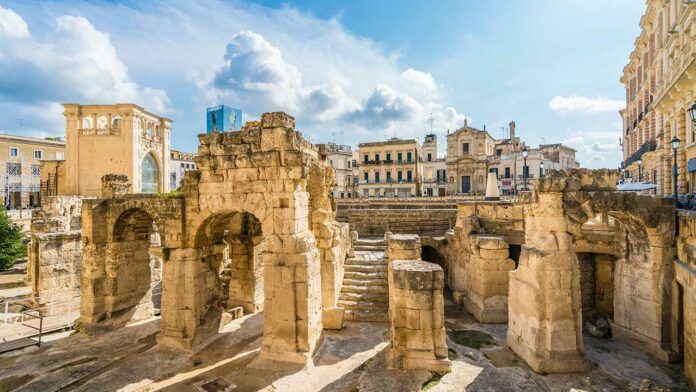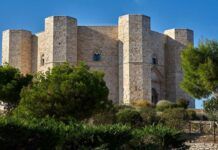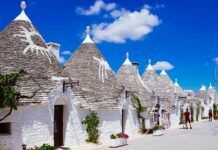Cradle of Salento Baroque, Lecce is a magical and culturally vibrant city, to be visited calmly, enjoying all the white nuances of its palaces and churches.
The history of Lecce, known as the “Florence of the South“, has its roots in a distant past and is marked by various dominations: from the Messapi, who founded the first settlements around the eighth century BC, the Romans, of which there are many well-preserved remains, until the Kingdom of Naples, from mid-1400 onwards, to which we owe wonderful palaces and baroque churches set in the streets of the center. A distinctive feature of Lecce is the Baroque style: a riot of statues, rich decorations and intricate lines, made with the so-called pietra leccese, a particularly malleable material, with a characteristic color ranging from white to beige and that dresses the whole city in white shades.
The streets of Lecce city center are an open-air museum, and walking there is like taking a dip in the Renaissance. An example of this is Piazza del Duomo, where the Cathedral of Maria SS. Assunta stands out, positioned in a corner, with its splendid 17th century facade and the imposing bell tower, which over the years has become one of the symbols of the city, but also a reference point to orient oneself in the maze of narrow streets of the historic center. Next to the cathedral stands the Bishop’s palace, with its splendid loggia, and to its right, the Seminary building, with its ashlar decorated facade, which now houses the Diocesan Museum of Sacred Art, as well as a characteristic inner courtyard, shaded by citrus trees.
Another admirable example of Lecce Baroque is the church of Sant’Irene dei Teatini, dedicated to the patron saint of the city until 1656. The façade is composed of a double order plant, with a portal surmounted by the stone statue of Saint Irene, while the interior, in perfect baroque style, is majestic and imposing, with a Greek cross and a single nave. Not to be missed is the Basilica of Santa Croce, built between the 16th century and the end of the 17th century. Its monumental façade, richly decorated with Christian symbols, Corinthian columns, grotesque or allegorical figures, fantastic animals and cherubs, and surmounted by a large central rose window, is, together with the adjacent Palazzo dei Celestini, the maximum manifestation of Lecce Baroque. Not far away, Piazza Sant’Oronzo, named after the patron saint of the city, contains other priceless masterpieces belonging to different periods and styles. Dominating the square with its 16th century elegance is the Palazzo del Sedile, over the years used for various institutional purposes and today home to art exhibitions and displays.
But what immediately attracts attention is undoubtedly the Roman amphitheater, elliptical in shape, dating back to the 2nd century AD, of which only a portion remains intact, but that lets you see all the splendor of its past. In front of the amphitheater is the Church of Santa Maria della Grazie, obviously in Baroque style, while in the center of the square stands the Column of Sant’Oronzo, with a wooden statue covered in bronze depicting the saint. Piazza Sant’Oronzo is the living room of the city, a traditional meeting place of Lecce and the scene of various public events. Nearby there is also the Church of San Giuseppe, another beautiful example of Baroque, and the Castle Carlo V, a fortified bastion built in 1500 by Emperor Carlo V. Strongly remodeled over the centuries, it preserves the original central body of the twelfth century. Once used for defensive purposes, today it also hosts art exhibitions and cultural initiatives.










